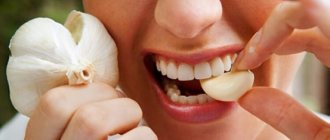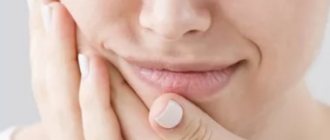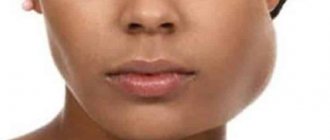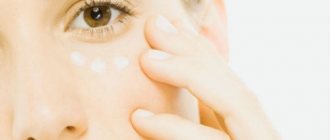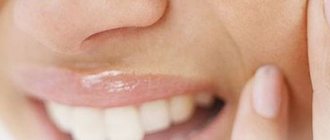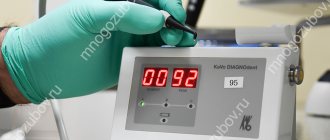This state cannot be called merely unpleasant or uncomfortable. Pulsating pain in a tooth can not only reduce a person’s quality of life - because of it, he may temporarily lose the ability to work normally, sleep, eat, etc. Dentists at the CrystalDent clinic urge all patients who are faced with this problem not to endure this condition in the expectation that it will go away on its own. The specialist strongly recommends immediately seeking help from a doctor and talks about the nature, causes, and methods of dealing with this problem.
Causes of throbbing tooth pain
It causes a feeling that at the site of its source someone or something is purposefully and monotonously hitting the nerve endings, tugging at them, causing them and the patient himself to shudder. This is approximately true, since it occurs due to mechanical irritation of a nerve bundle exposed for some reason, located in the soft tissues (pulp) of the tooth.
Throbbing pain can be either constant or occur periodically - when closing teeth, brushing them, touching them, eating, exposure to heat or cold, or any mechanical stress. It can last for several seconds or several hours, and in some cases it practically does not subside at all. In any case, this is a signal that urgent medical attention is required.
This, to put it mildly, unpleasant sensation may appear for the following reasons:
- Caries. This is one of the most common provocateurs of pain of this nature. When it occurs at an early stage, they can be almost imperceptible and short-lived. But as the problem progresses, they intensify, since the hard tissues that protect the pulp from external influences are gradually destroyed;
- Pulpitis. This pathology is a consequence of the destruction of hard dental tissues, which exposes the nerve of the tooth. Most often, this inflammatory process develops as a result of deep caries that has reached the final stages. With pulpitis, the patient feels severe throbbing pain in the tooth, which can radiate to the ear, temple, and even to the neck, eyes, and nose. It can make itself felt either periodically or not recede for a long time;
- Thinning, damage to tooth enamel. In such cases, a reaction of the nerve bundle to external stimuli is also possible;
- Mechanical damage to the tooth due to trauma. If, as a result of the latter, the hard tissues protecting the pulp are destroyed, it becomes exposed, and therefore reacts to any external influence;
- Periodontitis. This disease is an inflammatory process that occurs in the tissues around the apex of the tooth. In this case, the throbbing pain may intensify when touching not only the patient himself, but also the gum, which may also be inflamed;
- Periodontitis. With this pathology, inflammation develops in bone tissue, and, as a rule, this is a consequence of their infection;
- Incorrectly installed filling or insufficient treatment. Patients often complain that throbbing pain appears after filling, and in such cases the reasons may be different. For example, under a temporary filling it may appear due to the effect of a drug that kills the nerve that needs to be removed, and this option is normal. Once treatment is completed and a permanent filling is installed, this problem usually goes away. At the same time, during the treatment process, the doctor must be sure that pain is not a consequence of insufficient treatment. But there are also situations when throbbing pain appears even after the end of treatment. This may also be a variant of the norm - the injured tissues are still healing, and after a few days the discomfort will subside. If this does not happen, it is possible that the tooth was treated poorly (for example, the nerve was not completely removed or the pulp was injured by mechanical forces). It is also possible that a permanent filling is installed incorrectly, which literally puts pressure on the nerve bundle. In both of the latter cases, re-treatment and/or re-filling should be performed.
The problem can also appear after tooth extraction, and in some cases it signals infection of the hole that remains after it.
There are also situations when it is difficult for the patient to determine the localization of these sensations. To accurately establish it, sometimes an in-person examination by a doctor is not enough, but an x-ray will help do this.
Possible complications
If dental pathologies are not treated in a timely manner, a person risks facing unpleasant consequences :
- Teeth will react to sweet, salty, hot and cold foods. The pain syndrome after consuming unwanted products sometimes does not go away for days.
- A person will face the development of tooth decay, the formation of holes, and the destruction of enamel.
- An unpleasant odor will emanate from the mouth, which is difficult to remove with chewing and absorbable drugs.
- An untreated inflammatory process can develop into a cyst or phlegmon.
Attention! In the absence of competent therapy, the patient runs the risk of periostitis, abscess and bone atrophy.
First aid for throbbing tooth pain
These sensations are sometimes unbearable, and in order to calm them down a little, various painkillers are used.
The following medications can be used:
- Nonsteroidal anti-inflammatory drugs (NSAIDs). Such medications can relieve pain for several hours. In addition, they have anti-inflammatory effects. The most effective painkillers in this category are Ibuprofen, Ketanov, Ketorolac, Ketorol;
- Derivatives of phenylacetic acid. These drugs have not only analgesic, but also anti-inflammatory effects. Their most popular and effective representatives are “Aceclofenac”, “Diclofenac”;
- Such remedies as “Indomethacin”, “Nise” also help to temporarily eliminate throbbing toothache;
- If the sensations are not too pronounced, Paracetamol, Aspirin, and Analgin will help temporarily numb the tooth.
There are also folk remedies that help relieve pain for a short time:
- Ice. It is wrapped in cloth or gauze and applied to the cheek;
- Rinse with soda solution. To prepare it, 1 tsp. soda is dissolved in a glass of warm (but not hot) water, and the resulting composition is rinsed in the mouth. You can add a little iodine (a couple of drops) and salt to the solution;
- Rinse with sage decoction. It is prepared by pouring boiling water (1 cup) over the herb (0.5 tsp), and then sending the mixture to a steam bath for a third of an hour. When the broth has cooled (but it should not become cold), it is decanted and used for rinsing.
Using any methods of pain relief, first of all, you need to carefully clean the oral cavity and the diseased tooth itself from plaque, using toothpaste and a brush.
It is very important to consider the following points:
- The use of painkillers is not a treatment, but only a temporary elimination of symptoms to alleviate the patient’s condition before his visit to the dentist;
- The given examples of drugs and traditional methods are not universal and guaranteed to be effective. In some cases, using any of them can even be harmful. Be sure to contact your doctor to see what steps you can take to relieve your condition. Only a doctor can determine the means that will help do this in each specific case.
Some patients, feeling that the pain has subsided, believe that the problem has passed. This is a big misconception! Eliminating symptoms does not eliminate the disease, so a visit to the dentist is inevitable if you do not want to allow the pathology to rapidly progress and lead to more serious consequences.
If you have an acute toothache, where should you go urgently?
At home, you can reduce or stop pain for a while, but there are situations when severe toothache in an adult or child is unbearable and is accompanied by swelling or fever. In this case, you need to immediately contact the clinic, if necessary, 24 hours a day. This way, you have a much better chance of getting enough sleep, because caries can be removed in a few minutes, but you can suffer with a tooth at home for many hours. But where to go with acute toothache at night? If it is not possible to contact the dentist on duty, seek emergency help for toothache in an ambulance. Specialists will administer a pain-relieving injection, which will help you wait until your visit to the dentist.
Professional treatment
Its tactics and volume are determined by the doctor, and it depends on the causes of the problem and the condition of the diseased tooth. After an in-person examination, if necessary, the specialist sends the patient for an x-ray in order to accurately determine the location of the lesion and examine the condition of the root and dental tissues.
Based on a preliminary study, the following assistance can be provided to the patient:
- Treatment of caries;
- Depulpation of the tooth with treatment and subsequent filling of the dental canals;
- If its tissues are severely damaged, it may be necessary to install a crown or other types of prostheses (for example, veneers, lumineers);
- If the cause of the pain lies in a root disease, if possible, it is treated by opening the canals. It is possible that resection of its apex will be required to eliminate the source of inflammation and preserve the tooth;
- In some cases, it is not possible to avoid completely removing the latter.
If discomfort occurs after filling, and the reason lies in improper treatment, the filling is opened, the canals are treated, if necessary, and then the filling is repeated.
Diagnostics
A comprehensive examination of the condition of teeth and soft tissues is considered the main step before starting competent dental treatment.
Lack of diagnosis leads to incorrect selection of drugs and the development of adverse reactions. Research methods are prescribed on an individual basis, depending on the patient’s health condition.
The universal rules of examination include:
- Taking an anamnesis , talking with the patient about the symptoms that bother him, visual inspection of the problem area, palpation of painful areas.
- Inspection and verification of installed fillings and prostheses.
- Checking occlusion , identifying jaw defects, detecting injuries to gums or teeth.
- X-ray diagnostics . The procedure helps to assess the condition of soft tissues, identify irregularities, inflammation and various pathologies. X-rays are used to detect hidden cavities. The procedure helps to evaluate the shape of the canals and find out their number.
- Targeted radiology . The procedure is carried out using a radiovisiograph, which helps to assess the internal condition of the teeth. The resulting image is of good quality and allows you to carefully examine the problem area.
- Panoramic shot . During the process, the patient is given a detailed photograph, allowing the condition of two jaws to be assessed at once. Using a panoramic image, the doctor has the opportunity to carefully examine the tissues surrounding the diseased tooth. This diagnostic method helps to detect the first signs of caries, inflammation, damage to the root system, and the development of cystic neoplasms.
- CT . Computed tomography is used to obtain more detailed information about the condition of the patient's teeth. Most often, this study is prescribed for serious jaw injuries, swelling, and purulent inflammation. Also, a CT scan will be required before implant therapy.
- Electroodontometry . The procedure helps determine the condition of the pulp located in the pulp chamber of the tooth.
Reference! In some cases, the fluorescent method, temperature tests, and special colored markers are used to assess the condition of teeth.
Prevention
No one is immune from diseases and the discomfort associated with them, but measures can be taken to reduce the risk of encountering them. In the case of dental problems, including throbbing pain in the tooth, they are as follows:
- Inspect your mouth regularly to detect early caries early. If you notice it, contact your doctor immediately to get it eliminated as quickly as possible. At the initial stages of its development, it is possible not only to preserve the tooth, but also the nerve in it, which means that it will remain “alive” and will last for many years;
- Regularly visit the dentist - he will see with a professional eye possible problems that the patient himself did not notice, and immediately begin treatment;
- Strictly adhere to the rules of oral hygiene - you need to brush your teeth twice a day, doing it thoroughly and for at least 2-3 minutes. After eating, use dental floss and special rinses;
- Don't skip professional oral cleaning. With its help, it is possible to remove plaque that a regular toothbrush cannot cope with. It often becomes the cause of the development of caries, other dental problems and all their negative consequences;
- As soon as pain makes itself felt, do not delay in seeing a doctor. They are always a “bell” that a pathology is developing, but it will not go away on its own, and without the help of a specialist it will only get worse.
The dentists of the CrystalDent clinic draw the attention of patients to the fact that it is very important to find an experienced, responsible doctor who can provide professional assistance to the required extent, and not only quickly relieve pain, but also save the tooth, do everything to ensure that it served for many more years.
Kostyuk Anna Vladimirovna
Orthopedic dentist of the first category
Did you like the article?
Rate: (no rating)
Loading…
Indications for removal
- Pathological eruption of the figure eight (partial or complete retention, dystopia), accompanied by pain, chronic inflammation of the gums, destruction of adjacent molars, malocclusion, damage to the jaw joint and other problems;
- 3 molar has erupted outside the dentition, leading to crowding;
- inability to carry out treatment or prosthetics due to limited access to the dental unit;
- the presence of complications - cysts, granulomas, periostitis, periodontitis;
- orthodontic treatment - figure eights must be removed if they interfere with the installation of a corrective apparatus or prevent the teeth from taking the correct position when correcting the bite.
Memo for patients
- Do not delay visiting your doctor if there are signs of an allergic reaction.
- If the pain increases, swelling, redness, or fever appears, make an emergency appointment
- Do not relieve pain with antibiotics unless prescribed by a doctor.
- Do not use alcohol or garlic applications, as they can burn the mucous membrane.
- Never heat your tooth
- Follow all dentist recommendations
A qualified doctor, a clinic with modern digital equipment and following the recommendations will help you avoid situations where a tooth hurts after installing a filling.
Expert of the article Bolshakova Evgenia Vladimirovna Dentist-hygienist
More than 11 years of experience
Recovery after surgery
The removal of the figure eight itself is painless, since it is performed under anesthesia. But due to injury to the gums and bone socket, after the anesthetic wears off, the figure eight, or rather the periodontal tissues, hurt for several days. Painful sensations after a simple removal usually go away within 2-3 days, after a complex one they can persist for about a week. On days 2-3, swelling increases, which subsides after 2 days and the pain subsides. After the intervention, the doctor gives recommendations regarding care, nutrition, lifestyle, and prescribes drug therapy - antibiotics, painkillers, anti-inflammatory drugs, antihistamines.

